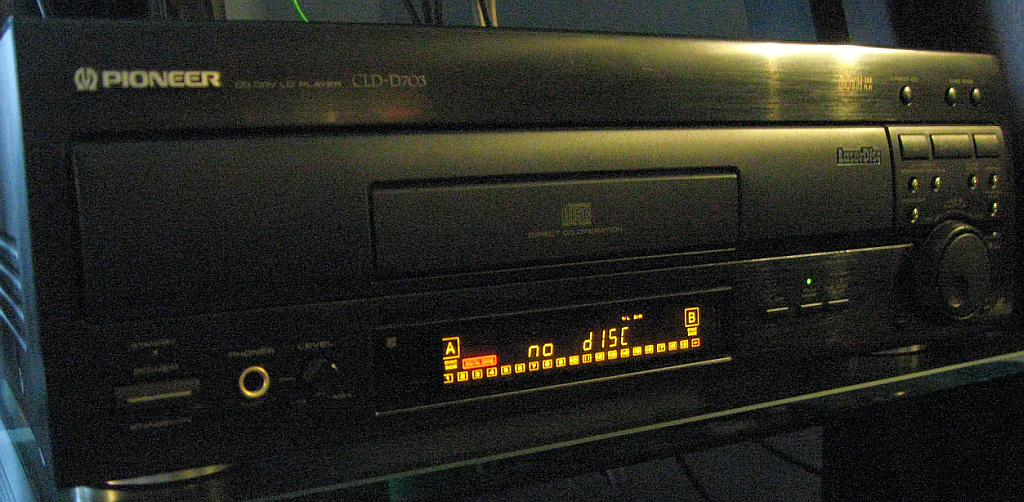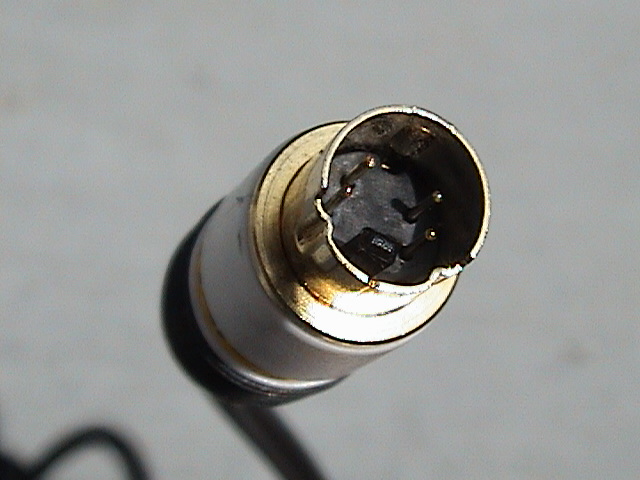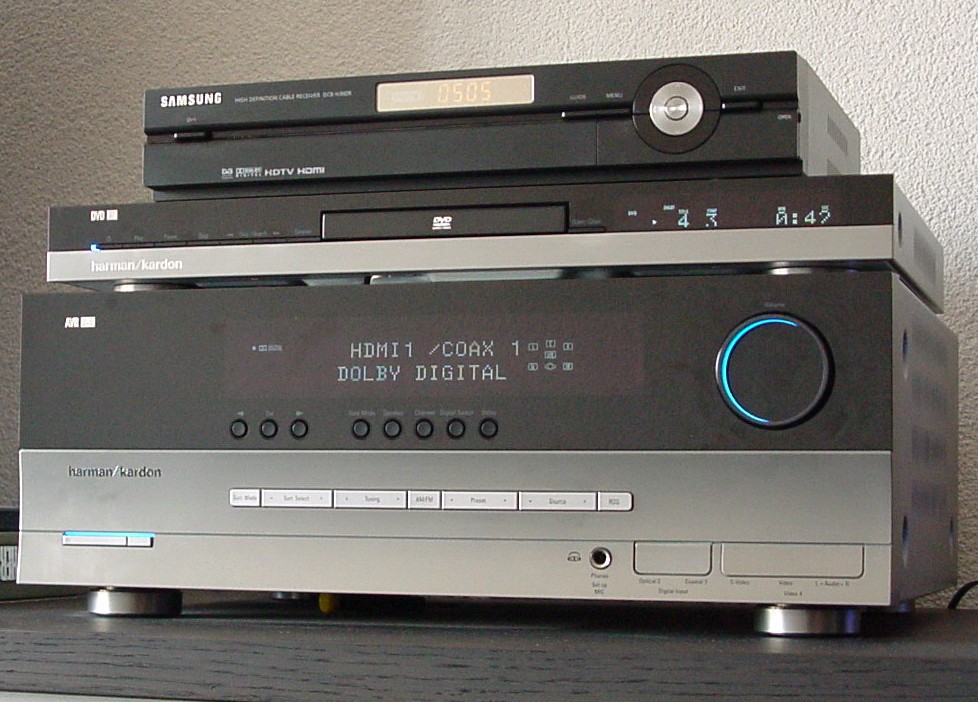|
Pioneer CLD-D703
The Pioneer CLD-D703, or the CLD-D770 in non-North American marketplaces, was a part of Pioneer's 700 Series of upper mid-range LaserDisc players, and the first player in the family and top of Pioneer's 1994 North American line. On the grounds of picture and audio quality, the 703 is widely considered one of the best non-Elite LaserDisc players ever made by Pioneer. It evolved into the CLD-D704, which itself was the basis for the CLD-79 and CLD-99 Elite line of high-end models. Information Pioneer introduced the CLD-D703 to provide a "stop gap" model to fit in between the CLD-D503, a lower mid-range player, and the more expensive, prior models in their Elite lineup. Although lacking an AC-3 RF output for transmission of Dolby Digital sound, it did include many high-end features including a 51db video signal-to-noise ratio, 116db audio signal-to-noise ratio, quick Gamma-Turn side flip, Digital Field Memory (allowing for freeze frame and slow motion options on CLV discs), One Shot ... [...More Info...] [...Related Items...] OR: [Wikipedia] [Google] [Baidu] |
Pioneer CLD-D703
The Pioneer CLD-D703, or the CLD-D770 in non-North American marketplaces, was a part of Pioneer's 700 Series of upper mid-range LaserDisc players, and the first player in the family and top of Pioneer's 1994 North American line. On the grounds of picture and audio quality, the 703 is widely considered one of the best non-Elite LaserDisc players ever made by Pioneer. It evolved into the CLD-D704, which itself was the basis for the CLD-79 and CLD-99 Elite line of high-end models. Information Pioneer introduced the CLD-D703 to provide a "stop gap" model to fit in between the CLD-D503, a lower mid-range player, and the more expensive, prior models in their Elite lineup. Although lacking an AC-3 RF output for transmission of Dolby Digital sound, it did include many high-end features including a 51db video signal-to-noise ratio, 116db audio signal-to-noise ratio, quick Gamma-Turn side flip, Digital Field Memory (allowing for freeze frame and slow motion options on CLV discs), One Shot ... [...More Info...] [...Related Items...] OR: [Wikipedia] [Google] [Baidu] |
Laserdisc
The LaserDisc (LD) is a home video format and the first commercial optical disc storage medium, initially licensed, sold and marketed as DiscoVision, MCA DiscoVision (also known simply as "DiscoVision") in the United States in 1978. Its diameter typically spans . Unlike most optical disc standards, LaserDisc is not fully Digital data, digital, and instead requires the use of analog video signals. Although the format was capable of offering higher-quality video and audio than its consumer rivals—VHS and Betamax videotape—LaserDisc never managed to gain widespread use in North America, largely due to high costs for the players and the inability to record TV programmes. It eventually did gain some traction in that region and became somewhat popular in the 1990s. It was not a popular format in Europe and Australia. By contrast, the format was much more popular in Japan and in the more affluent regions of Southeast Asia, such as Hong Kong, Singapore and Malaysia, and was the ... [...More Info...] [...Related Items...] OR: [Wikipedia] [Google] [Baidu] |
Ease Of Use
Usability can be described as the capacity of a system to provide a condition for its users to perform the tasks safely, effectively, and efficiently while enjoying the experience. In software engineering, usability is the degree to which a software can be used by specified consumers to achieve quantified objectives with effectiveness, efficiency, and satisfaction in a quantified context of use. The object of use can be a software application, website, book, tool, machine, process, vehicle, or anything a human interacts with. A usability study may be conducted as a primary job function by a ''usability analyst'' or as a secondary job function by designers, technical writers, marketing personnel, and others. It is widely used in consumer electronics, communication, and knowledge transfer objects (such as a cookbook, a document or online help) and mechanical objects such as a door handle or a hammer. Usability includes methods of measuring usability, such as needs analysis and t ... [...More Info...] [...Related Items...] OR: [Wikipedia] [Google] [Baidu] |
S-Video
S-Video (also known as separate video, Y/C, and erroneously Super-Video ) is an analog video signal format that carries standard-definition video, typically at 525 lines or 625 lines. It encodes video luma and chrominance on two separate channels, achieving higher image quality than composite video which encodes all video information on one channel. It also eliminates several types of visual defects such as dot crawl which commonly occur with composite video. Although it improved over composite video, S-Video has lower color resolution than component video, which is encoded over three channels. The Atari 800 was the first to introduce separate Chroma/Luma output in late 1979. However, S-Video did not get widely adopted until JVC's introduction of the S-VHS (Super-VHS) format in 1987, which is why it is sometimes incorrectly referred to as "Super-Video." Before the shift towards digital video the S-video format was widely used by consumers, but it was rarely used in professiona ... [...More Info...] [...Related Items...] OR: [Wikipedia] [Google] [Baidu] |
Comb Filter
In signal processing, a comb filter is a filter implemented by adding a delayed version of a signal to itself, causing constructive and destructive interference. The frequency response of a comb filter consists of a series of regularly spaced notches in between regularly spaced ''peaks'' (sometimes called ''teeth'') giving the appearance of a comb. Applications Comb filters are employed in a variety of signal processing applications, including: * Cascaded integrator–comb (CIC) filters, commonly used for anti-aliasing during interpolation and decimation operations that change the sample rate of a discrete-time system. * 2D and 3D comb filters implemented in hardware (and occasionally software) in PAL and NTSC analog television decoders, reduce artifacts such as dot crawl. * Audio signal processing, including delay, flanging, physical modelling synthesis and digital waveguide synthesis. If the delay is set to a few milliseconds, a comb filter can model the effect of acousti ... [...More Info...] [...Related Items...] OR: [Wikipedia] [Google] [Baidu] |
Electroluminescent
Electroluminescence (EL) is an optical and electrical phenomenon, in which a material emits light in response to the passage of an electric current or to a strong electric field. This is distinct from black body light emission resulting from heat (incandescence), a chemical reaction (chemiluminescence), sound (sonoluminescence), or other mechanical action (mechanoluminescence). Mechanism Electroluminescence is the result of radiative recombination of electrons & holes in a material, usually a semiconductor. The excited electrons release their energy as photons - light. Prior to recombination, electrons and holes may be separated either by doping the material to form a p-n junction (in semiconductor electroluminescent devices such as light-emitting diodes) or through excitation by impact of high-energy electrons accelerated by a strong electric field (as with the phosphors in electroluminescent displays). It has been recently shown that as a solar cell improves its light-to- ... [...More Info...] [...Related Items...] OR: [Wikipedia] [Google] [Baidu] |
DiscoVision
DiscoVision is the name of several things related to the video LaserDisc format. It was the original name of the "Reflective Optical Videodisc System" format later known as "LaserVision" or LaserDisc. Description MCA DiscoVision, Inc. was a division of entertainment giant MCA (Music Corporation of America), established in 1969 to develop and sell an optical videodisc system. MCA released discs pressed in Carson and Costa Mesa, California on the DiscoVision label from the format's Atlanta, Georgia launch in 1978 to 1982 and the release of the film, '' The Four Seasons''. DiscoVision titles included films from Universal Pictures, Paramount Pictures, Warner Bros. Pictures, and Disney content. Agreements were made with Columbia Pictures and United Artists, though no discs were released on the DiscoVision label from either studio. Most of these companies later established their own labels for the format, the first being Paramount with a dozen movies released on the Paramount Home Vid ... [...More Info...] [...Related Items...] OR: [Wikipedia] [Google] [Baidu] |
AV Receiver
An audio/video receiver (AVR) is a consumer electronics component used in a home theater. Its purpose is to receive audio and video signals from a number of sources, and to process them and provide power amplifiers to drive loudspeakers and route the video to displays such as a television, monitor or video projector. Inputs may come from a satellite receiver, radio, DVD players, Blu-ray Disc players, VCRs or video game consoles, among others. The AVR source selection and settings such as volume, are typically set by a remote controller. Usage The term "receiver" basically refers to an amplifier, typically at least a two-channel stereo model, that has a built-in radio tuner. With A/V receivers, the basic functionality is to receive an audio signal, amplify the audio signal to drive multiple speakers, and allow pass-through of the corresponding video signal to a display device such as a projector or a television. The receiver performs tasks that would otherwise require numerou ... [...More Info...] [...Related Items...] OR: [Wikipedia] [Google] [Baidu] |
DTS (sound System)
DTS, Inc. (originally Digital Theater Systems) is an American company that makes surround sound, multichannel audio technologies for film and video. Based in Calabasas, California, the company introduced its DTS technology in 1993 as a competitor to Dolby Laboratories, incorporating DTS in the film ''Jurassic Park (film), Jurassic Park'' (1993). The DTS product is used in surround sound formats for both commercial/theatrical and consumer-grade applications. It was known as The Digital Experience until 1995. DTS licenses its technologies to consumer electronics manufacturers. The DTS brand was acquired by Tessera Holding Corporation in December 2016, then Tessera was renamed to Xperi Corporation. History DTS was founded by Terry Beard, an audio engineer and Caltech graduate. Beard, speaking to a friend of a friend, was able to get in touch with Steven Spielberg to audition a remastering of Spielberg's film ''Close Encounters of the Third Kind'' mixed in DTS. Spielberg then select ... [...More Info...] [...Related Items...] OR: [Wikipedia] [Google] [Baidu] |
Pioneer CLD-D703 Playback FAIR USE ONLY
Pioneer commonly refers to a settler who migrates to previously uninhabited or sparsely inhabited land. In the United States pioneer commonly refers to an American pioneer, a person in American history who migrated west to join in settling and developing new areas. Pioneer, The Pioneer, or pioneering may also refer to: Companies and organizations * Pioneer Aerospace Corporation *Pioneer Chicken, an American fast-food restaurant chain *Pioneer Club Las Vegas, a casino in Las Vegas, Nevada, U.S. * Pioneer Corporation, a Japanese electronics manufacturer *Pioneer Energy, a Canadian gas station chain * Pioneer Entertainment, a Japanese anime company *Pioneer Hi-Bred, a U.S.-based agriculture company *Pioneer Hotel & Gambling Hall, Laughlin, Nevada, U.S. *Pioneer Instrument Company, an American aeronautical instrument manufacturer *Pioneer movement, a communist youth organization *Pioneer Natural Resources, an energy company in Texas, U.S. * Pioneer Pictures, a former American film st ... [...More Info...] [...Related Items...] OR: [Wikipedia] [Google] [Baidu] |
CD Video
CD Video (also known as CDV, CD-V, or CD+V) is a format of optical media disc that was introduced in 1987 that combines the technologies of standard compact disc and LaserDisc. CD-V discs are the same size as a standard 12-cm audio CD, and contain up to 20 minutes' worth of CD audio that can be played on any audio CD player. It also contains up to 5 minutes of LaserDisc video information with digital CD-quality sound, which can be played back on a newer LaserDisc player capable of playing CD-V discs or CD-V-only players. The "CD Video" brand was also used to market some 20 and 30 cm LaserDiscs which included a digital soundtrack but no CD-compatible content. Description 12 cm "CD Video" disc format One of the first LaserDisc players that can play CD-V discs is the Pioneer CLD-1010 from 1987. Though it is a CD-based format, CD Video was never given a rainbow book designation; the idea of encoding analogue video, which is incompatible between different regions, was poorly rec ... [...More Info...] [...Related Items...] OR: [Wikipedia] [Google] [Baidu] |
Compact Disc
The compact disc (CD) is a Digital media, digital optical disc data storage format that was co-developed by Philips and Sony to store and play digital audio recordings. In August 1982, the first compact disc was manufactured. It was then released in October 1982 in Japan and branded as ''Compact Disc Digital Audio, Digital Audio Compact Disc''. The format was later adapted (as CD-ROM) for general-purpose data storage. Several other formats were further derived, including write-once audio and data storage (CD-R), rewritable media (CD-RW), Video CD (VCD), Super Video CD (SVCD), Photo CD, Picture CD, Compact Disc-Interactive (CD-i) and Enhanced Music CD. Standard CDs have a diameter of and are designed to hold up to 74 minutes of uncompressed stereo digital audio or about 650 mebibyte, MiB of data. Capacity is routinely extended to 80 minutes and 700 mebibyte, MiB by arranging data more closely on the same sized disc. The Mini CD has various diameters ranging from ; t ... [...More Info...] [...Related Items...] OR: [Wikipedia] [Google] [Baidu] |





.jpg)
